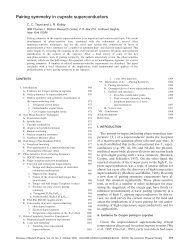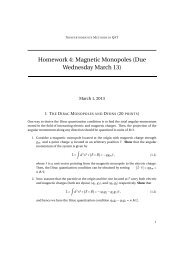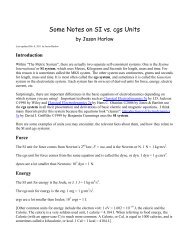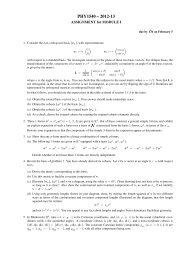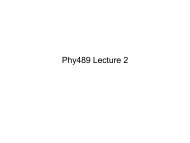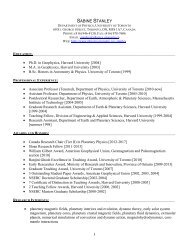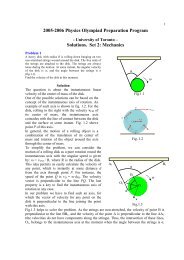A Guide to Solving Simple Ordinary Differential Equations (ODE's)
A Guide to Solving Simple Ordinary Differential Equations (ODE's)
A Guide to Solving Simple Ordinary Differential Equations (ODE's)
Create successful ePaper yourself
Turn your PDF publications into a flip-book with our unique Google optimized e-Paper software.
A <strong>Guide</strong> <strong>to</strong> <strong>Solving</strong> <strong>Simple</strong> <strong>Ordinary</strong> <strong>Differential</strong><br />
<strong>Equations</strong> (ODE’s)<br />
I. Motivation<br />
Brian Frederick Mullins<br />
University of Toron<strong>to</strong>, Department of Physics<br />
For many of you, this may be your first encounter with differential equations. The ability<br />
<strong>to</strong> derive and solve differential equations is essential in most scientific and many nonscientific<br />
fields. There are many classes of these equations that describe a wide variety of<br />
physical phenomena ranging from the vibrating modes on a drumhead <strong>to</strong> the quantum<br />
mechanical description of an electron in a periodic potential. In our discussion, we will<br />
concentrate on learning how <strong>to</strong> solve a very specific and simple differential equation.<br />
II. Bridging the Gap<br />
At first, the term “differential equation” may sound intimidating. However, be assured<br />
that differential equations are very similar <strong>to</strong> equations you have already encountered in<br />
your high school math courses such as the quadratic equation. There are two main<br />
differences between differential equations and the equations you are already familiar<br />
with. The first and most noticeable difference is that differential equations involve taking<br />
the derivative of a variable instead of a power. For comparison:<br />
Quadratic Equation:<br />
<strong>Differential</strong> Equation:<br />
2<br />
ax + bx + c = 0<br />
dx<br />
a + bx + c = 0<br />
dt<br />
The second difference is subtler: In the quadratic case, the variable we are solving for is<br />
a number, while in the differential case, we are solving for a function. If you have<br />
already taken calculus, you might have guessed this since you can only take the<br />
derivative of a function 1 . Let’s look at an example:<br />
Suppose we want <strong>to</strong> solve the following differential equation:<br />
1 A constant (number) is considered a function <strong>to</strong>o!<br />
2<br />
d x<br />
+ 4x= 0.<br />
(1)<br />
2<br />
dt<br />
1
We know this is a differential equation because it involves a derivative (in this case it is<br />
the second derivative of x with respect <strong>to</strong> t). In order <strong>to</strong> make this problem easier <strong>to</strong> read,<br />
let’s isolate the derivate term by rewriting equation (1) as:<br />
2<br />
d x<br />
=− 4x<br />
(2)<br />
2<br />
dt<br />
Recognize that the variable x is a function of t since we a differentiating with respect <strong>to</strong> t.<br />
Now, by looking at equation (2) we can ask: What function x(t) can be differentiated<br />
twice <strong>to</strong> equal the same function multiplied by constant -4? Let’s randomly guess a<br />
solution<br />
xt ()= t<br />
3 . The second derivative of<br />
in<strong>to</strong> our differential equation (1) gives:<br />
2<br />
t 3 is<br />
3<br />
6t. Substituting<br />
x = t<br />
3 and<br />
2<br />
d x<br />
= 6t<br />
2<br />
dt<br />
6t+ 4t ≠ 0<br />
(3)<br />
Equation (3) shows that our guess xt ()= t<br />
3 is not a solution <strong>to</strong> equation (1) (and hence<br />
not a solution <strong>to</strong> equation (2)) since the equality in equation (3) is not satisfied 2 . Let’s<br />
guess again by trying the function x( t) = cos( 2 t)<br />
. The second derivative of cos( 2t<br />
) is<br />
2<br />
d x<br />
−4cos( 2t<br />
) . Substituting x = cos( 2 t)<br />
and =−4cos( 2t)<br />
in<strong>to</strong> equation (1) gives:<br />
2<br />
dt<br />
− 4cos( 2t) + 4cos( 2t ) = 0<br />
(4)<br />
We find that the equality in equation (4) is satisfied. Therefore,<br />
solution <strong>to</strong> the differential equation (1).<br />
III. <strong>Solving</strong> <strong>Simple</strong> ODE’s – “The Standard Lawn Mower”<br />
x( t) = cos( 2 t)<br />
is a<br />
Hopefully, you now have a better feel for differential equations. In the example above,<br />
we just guessed some functions and tried <strong>to</strong> see if they were solutions by simply<br />
substituting them directly in<strong>to</strong> the differential equation (the first time we were not<br />
successful, but the second time we were). Now let’s be honest with ourselves – most of<br />
us aren’t very good guessers, so we need a technique that will give us the right function<br />
without some divine revelation. The following description is a mechanical procedure<br />
2<br />
b b ac<br />
(i.e., no thinking involved – much like using x =<br />
a<br />
− ± −4<br />
when solving quadratic<br />
2<br />
equations) that will solve differential equations of the following form:<br />
dx<br />
dt<br />
− bf( x) g( t)<br />
= 0<br />
2 The term on the left side of the “=” sign does not equal the term on the right side of the “=” sign.
In this equation, x is a function of t, f(x) is some function of x, g(t) is some function of t<br />
and b is a constant. No attempt at mathematical justification will be given for this<br />
technique except <strong>to</strong> show though example that it works. We will demonstrate this<br />
procedure with the following example:<br />
In the equation above, let x = V, f(x) = V, g(t) = 1 and b = 6, where V is some function of<br />
t. Therefore, our example differential equation is:<br />
dV<br />
dt<br />
− 6V= 0 (1)<br />
Step (1) Isolate one term on each side of the equals sign:<br />
• Add 6V <strong>to</strong> both sides of (1):<br />
dV<br />
dt<br />
= 6 V<br />
(2)<br />
Step (2) Split the derivative so that there is only one differential on each side of<br />
the equation:<br />
A differential is a fancy “d” followed by a variable name (i.e., dV). The<br />
differential tells you what variable <strong>to</strong> integrate with respect <strong>to</strong> (just as the<br />
dx<br />
dt in tells you <strong>to</strong> differentiate with respect <strong>to</strong> t, but there will be more<br />
dt<br />
on integration later).<br />
• Multiply both sides of equation (2) by dt:<br />
dV = 6 Vdt<br />
(3)<br />
Step (3) Collect like variables including the differentials on each side of the<br />
equation:<br />
In this case we want all V’s and dV’s on the left side and all t’s and dt’s on<br />
the right.<br />
• Divide both sides of equation (3) by V:<br />
dV<br />
V<br />
= 6 dt<br />
(4)<br />
Step (4) Slap integral signs on both sides of the equation:<br />
dV<br />
∫ = dt<br />
V ∫ 6 (5)<br />
3
These integrals are called indefinite integrals because they don’t have<br />
upper and lower bounds above and below the integral signs. There are<br />
actually an infinite number of functions (differing only by a constant) that<br />
satisfy (is the anti-derivative of) an integral.<br />
Step (5) Put upper and lower bounds on the integrals:<br />
Vf tf<br />
dV<br />
∫ = dt<br />
V ∫ 6 (6)<br />
Vi ti<br />
These integrals are now called definite (or exact) integrals because they<br />
contain upper and lower bounds (Vf, tf and Vi, ti respectively). The<br />
bounds serve <strong>to</strong> “nail down” one function from the infinite set of possible<br />
functions. For each integral, the upper bound contains the final value of<br />
the variable that we are integrating with respect <strong>to</strong>, and the lower bound<br />
contains the initial value (also known as the initial condition).<br />
Step (6) Evaluate the integrals on each side of the equation:<br />
Ok, some of you may not have integrated before. Don’t worry if you<br />
don’t know how <strong>to</strong> take the integral (anti-derivative) of a function. Most<br />
integrals are <strong>to</strong>o complex and time consuming <strong>to</strong> solve by hand, so like<br />
most people you can just look the integral up in a book 3 or get a computer<br />
<strong>to</strong> solve it.<br />
Evaluating a definite integral involves two steps:<br />
Sub-step (1) Evaluate the indefinite integral – that is, take the antiderivative:<br />
The first indefinite integral on the left hand side of equation<br />
(5) is:<br />
1<br />
∫ dV = ln( V) + A<br />
V<br />
where A is an arbitrary constant.<br />
The second indefinite integral on the right hand side of<br />
equation (5) is:<br />
3 Tables of indefinite integrals can be found almost anywhere. A good source <strong>to</strong> start with is at the back of<br />
a calculus textbook. The CRC Handbook of Chemistry and Physics has good integral coverage and one of<br />
the better references is Shaum’s Mathematical Handbook of Formulas and Tables. Note: Most texts don’t<br />
include the constant – it is assumed <strong>to</strong> be there.<br />
4
∫<br />
6dt = 6 dt = 6t+<br />
B<br />
where B is an arbitrary constant.<br />
5<br />
∫<br />
Sub-Step (2) Nail down the exact function from the upper and lower<br />
bounds:<br />
Step (7) Combine the results:<br />
Step (8) Small celebration:<br />
There is a theorem called the Fundamental Theorem of<br />
Calculus that shows how <strong>to</strong> evaluate definite integrals:<br />
If ∫ f( x) dx = g( x) + C is the indefinite integral where<br />
g(x) is the anti-derivative of f(x)and C is an arbitrary<br />
b<br />
b<br />
constant. Then ∫ f( x) dx = ( g( x) + C) = g( b) − g( a)<br />
a<br />
a<br />
is the definite integral where b and a are the upper and<br />
lower bounds respectively and b > a.<br />
Using the upper and lower bounds on the left hand side of<br />
equation (5), the first definite integral evaluates <strong>to</strong>:<br />
Vf<br />
Vi<br />
( ln( V) + A) = ln( Vf )− ln(<br />
Vi)<br />
(7)<br />
Using the upper and lower bounds on the right hand side of<br />
equation (4), the second definite integral evaluates <strong>to</strong>:<br />
tf<br />
ti<br />
• Equate equations (7) and (8):<br />
( 6t+ B) = 6tf − 6ti<br />
(8)<br />
ln( Vf) − ln( Vi) = 6( tf) −6<br />
( ti)<br />
(9)<br />
So there you are. You have just solved a differential equation. Equation<br />
(9) is the solution <strong>to</strong> equation (1)! Unfortunately, the solution may not be<br />
in the form you want it, so we need <strong>to</strong> do some more algebra…<br />
Step (9) Solve for the variable you want <strong>to</strong> isolate/calculate:
In equation (9), let’s say V is velocity and t is time. Now let’s say we<br />
want <strong>to</strong> solve for the final velocity Vf as a function of the final time tf<br />
assuming we have constant values for the initial conditions Vi and ti.<br />
From equation (9):<br />
ln( Vf) = ln( Vi) + 6( tf) −6(<br />
ti)<br />
We need <strong>to</strong> kill the ln’s in order <strong>to</strong> isolate Vf. Take the exponential<br />
of both sides of the equation:<br />
ln( Vf ) ln( Vi) + 6( tf ) −6(<br />
ti)<br />
e = e<br />
by the properties of exponential functions:<br />
6( tf ) −6(<br />
ti)<br />
Vf = Vi ⋅e<br />
e<br />
6<br />
(10)<br />
Since Vi and ti are constants, so are their exponentials. Therefore we can<br />
write:<br />
6( tf )<br />
Vf = Ae<br />
where<br />
A= Vi⋅e −6( ti)<br />
(11)<br />
(12)<br />
Finally, equations (11) and (12) form our solution. Note that Vf in<br />
equation (11) is a function of time tf – remember we were solving for a<br />
function.<br />
Step (10) Check solution by substituting it back in<strong>to</strong> the original differential<br />
equation:<br />
In this example, we used the naming conventions Vf and tf <strong>to</strong> avoid<br />
confusion with the integration variables V and t respectively. It may seem<br />
confusing at first, but V and t are called “dummy variables” (i.e., they can<br />
be named anything like τ or ψ) whose only purpose is <strong>to</strong> perform the<br />
integration. It is the upper and lower bounds that give the final solution its<br />
variable name. Since we are solving for the final velocity in terms of time,<br />
we can arbitrarily rename Vf = V(t) and tf = t. Equation (11) then<br />
becomes:<br />
6()<br />
t<br />
Vt () = Ae<br />
where<br />
A= Vi⋅e −6( ti)<br />
and Vi and ti are the initial conditions<br />
(13)
IV. Final Remarks<br />
• Substitute V Ae t 6( ) dV<br />
= and Ae<br />
dt<br />
t 6( )<br />
= 6 in<strong>to</strong> equation (1)<br />
6() t 6()<br />
t<br />
6Ae − 6Ae = 0<br />
(14)<br />
Since the equality in equation (14) is satisfied, equation (13) is indeed a<br />
solution <strong>to</strong> our original differential equation (1).<br />
The process of solving differential equations may seem complicated at first, but with a bit<br />
of practice you’ll soon find it’s very easy. Hopefully you will realize that the real power<br />
of calculus is unleashed when used <strong>to</strong> solve differential equations.<br />
7




